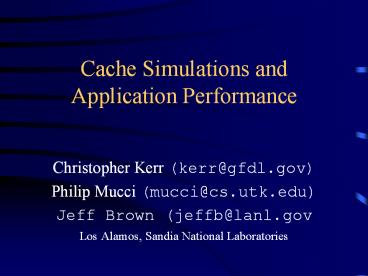Cache Simulations and Application Performance - PowerPoint PPT Presentation
Title:
Cache Simulations and Application Performance
Description:
Run-time library to be linked with the application (C) Works with: ... 1 B(i,k):7:kji.f. 2 C(k,j):7:kji.f. Address dump. Symbolic name. Virtual address. Cache line ... – PowerPoint PPT presentation
Number of Views:42
Avg rating:3.0/5.0
Title: Cache Simulations and Application Performance
1
Cache Simulations and Application Performance
- Christopher Kerr (kerr_at_gfdl.gov)
- Philip Mucci (mucci_at_cs.utk.edu)
- Jeff Brown (jeffb_at_lanl.gov
- Los Alamos, Sandia National Laboratories
2
Goal
- To optimize large, numerically intensive
applications with poor cache utilization. - By taking advantage of the memory hierarchy and
we can often achieve the greatest performance
improvements for our time.
3
Philosophy
- By simulating the cache hierarchy, we wish to
understand how the applications data maps to a
specific cache architecture. - In addition, we wish to understand the
applications reference pattern and the
relationship to the mapping. - Performance improvements can be obtained from
this information algorithmically.
4
Cache Simulator
- Consists of
- Instrumentation assistant (Perl)
- Header files
- Run-time library to be linked with the
application (C) - Works with
- C, C, Fortran 77, Fortran 90
5
How it works
- Cache simulator is called on memory (array)
references - Cache simulator reads a configuration file
containing an architectural description of the
memory hierarchy for multiple machines. - Environment variables enable different options
6
How it works (cont)
- Each call to the simulator provides as input
- Address of the reference
- Size of the datum being accessed
- Symbolic name consisting of the name, file and
line number
7
Instrumentation (before)
- subroutine kji(A, ii, jj, lda, B, kk, ldb, C,
ldc) - dimension A(lda,lda), B(ldb,ldb),
C(ldc,ldc) - do k 1, kk
- do j 1, jj
- do i 1, ii
- A(i,j) A(i,j) B(i,k) C(k,j)
- enddo
- enddo
- enddo
- return
- end
8
Instrumentation (after)
- .
- .
- .
- do i 1, ii
- call cache_sim(A(i,j),KIND(A(i,j)),
- 'A(i,j)7stdin\0')
- call cache_sim(A(i,j),KIND(A(i,j)),
- 'A(i,j)7stdin\0')
- call cache_sim(B(i,k),KIND(B(i,k)),
- 'B(i,k)7stdin\0')
- call cache_sim(C(k,j),KIND(C(k,j)),
- 'C(k,j)7stdin\0')
- A(i,j) A(i,j) B(i,k) C(k,j)
- enddo
- .
- .
- .
9
Output
- Summary
- Misses by name
- Misses by address
- Conflict matrix
- Address trace
10
Summary
- Machine 1 test-machine
- Cache level 1 size 32kB, line size 32B,
associativity 2, 1024 lines total - --------------------------------
- Total mem accesses 166492.00
- Total cache misses 10276.00
- Total cache hits 156216.00
- Total hit rate 93.83
- --------------------------------
- Num split accesses 0.00
- Cold cache misses 1024.00
- Real misses 9252.00
- Real hit rate 94.41
11
Misses by name
- Name Trace miss rate for references gt 0
percent. - Percentage Real misses
LineFileReference - 0.01 1.000
X(i,j)26stencil.F - 0.01 1.000
X(i,j-1)26stencil.F - 9.08 840.000
R(i,j)26stencil.F - 0.12 11.000
X(i1,j-1)26stencil.F - 9.08 840.000
X(i1,j1)26stencil.F - 9.08 840.000
AN(i,j)26stencil.F - 7.61 704.000
ANE(i,j)17stencil.F - 7.61 704.000
AN(i,j)15stencil.F - 0.13 12.000
ANE(i,j-1)26stencil.F - 9.08 840.000
ANE(i,j)26stencil.F - .
- .
- .
12
Misses by address
- Address Trace miss rate for references gt 0
percent. - Percentage Real misses Address
LineFileReference - 0.01 1.000 0x32d60
R(i,j)13stencil.F - 0.01 1.000 0x32d80
R(i,j)13stencil.F - 0.01 1.000 0x32da0
R(i,j)13stencil.F - 0.01 1.000 0x32dc0
R(i,j)13stencil.F - 0.01 1.000 0x32de0
R(i,j)13stencil.F - 0.01 1.000 0x32e00
R(i,j)13stencil.F - .
- .
- .
13
Conflict matrix
- Each axis represents the different arrays
- X axis is replacer, Y is replacee
- Elements are the number of replacements of one
array element with another - Goal is to algorithmically determine optimal
layout, placement, padding and blocking. - This is a minimization problem.
14
Conflict matrix (cont)
- 0 1 2
- 0 100 50 20
- 1 20 10 10
- 2 50 0 0
- Num Name
- 0 A(i,j)7kji.f
- 1 B(i,k)7kji.f
- 2 C(k,j)7kji.f
15
Address dump
- Symbolic name
- Virtual address
- Cache line
- Goal is to use this for replay.
16
Future
- Handle nonblocking caches, replacement policies,
write strategies and buffering. - Add output file with starting address and extents
for each array. - Facility for replay of the simulator using the
address dump, and data regarding padding,
blocking and alignment. This will eliminates the
need for additional runs.
17
Future (cont)
- Categorize cold misses for repeatedly accessed
data items. - Provide cost metrics to analyze approximate
performance loss due to poor locality. - Full Lex/Yacc based parser.
- Perl/Tk GUI for finer control of instrumentation.
18
Future (cont)
- MPI, Thread aware
- Reduction in run-time requirements
- MUT integration
- Tools to compare data sets































